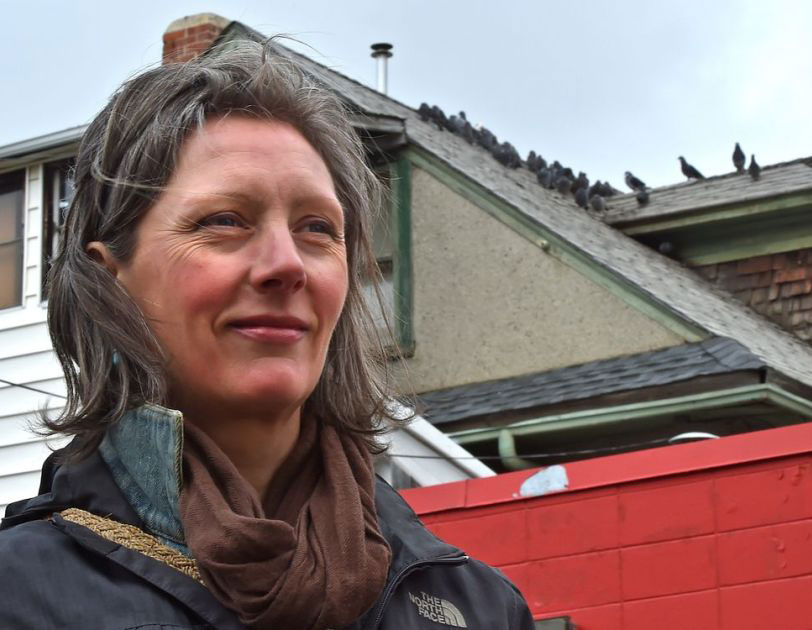
Kristine Kowalchuk, who is getting ready to build a pigeon cote as one step toward finding a new (old) way of managing pigeon populations and poop in urban environments. PHOTO: Ed Kaiser/Postmedia
We trap, poison or push these nuisance birds away from bridges and the ledges of downtown buildings, but perhaps pigeons are just misunderstood. At least, that's what a group of university researchers think. They're testing a new, er, old approach, really, to the problem of pigeon poop.
By this time next year, they'll have at least one attractive stone "pigeon cote" to house the birds, attracting them to one place in order to concentrate the poop and use it as fertilizer. It works with nature, rather than controlling it, and aims to restore an ancient, mutually-beneficial relationship that modern society simply forgot.
Yuck. Yes, I know. But intriguing as well. As city council heads into a week full of tough environmental decisions, I wonder if there's a broader wisdom here that can help.
But first, these pigeons.
Pigeons really are the flying kings of poop. One study found they poop up to 40 times a day, although English researcher Kristine Kowalchuk ('12 PhD) would put that closer to 10, based on what she saw from a rescued baby pigeon.
She was walking out of the Art Gallery of Alberta one afternoon in the spring of 2016 when she found the tiny bird sitting quietly in the gutter. She picked it up, carried it home and raised it in her spare room until it was too big and messy to keep any longer.
That's what got her thinking about pigeons, and the many references to squab (young pigeon) and the excellence of pigeon droppings as fertilizer she found littered throughout 17th century cookbooks and farming manuals during her English PhD.
It turns out farmers across Europe and North Africa would create large houses for free-ranging pigeons in fields or above their homes so that the birds would roost in one spot. That way both the young birds and poop could be harvested.
Now Kowalchuk, along with UAlberta professors Debra Davidson, an environmental sociologist, Howard Nye (Philosophy) and Aidan Rowe (Art & Design) using a $7,500 grant to build their own pigeon cote. It's being built on a farm near Camrose because none of the five organizations with pigeon problems they contacted here in the city would entertain the idea.
They're hoping a year observing the cote in action will change attitudes.
"We have so many misconceptions and cultural bias," says Kowalchuk, citing studies measuring the risk of getting sick from being around the poop as tiny, akin to getting sick from a pet dog or breaking a leg from slipping on a dandelion. The person shovelling it out periodically would simply wear a mask.

A pigeon cote in the Cottswolds region of England. Researcher Kristine Kowalchuk has been studying the role cotes played in a previous mutually-beneficial relationship between pigeons and humans. PHOTO: Kristine Kowalchuk
Plus, the cote itself doesn't increase populations; only feeding them does that, she says. "Our parks and flower beds could all benefit. Another way of looking at pigeons is entirely possible."
I love the simplicity of Kowalchuk's approach. I love the way it turns our pigeon problem on its head, resets a relationship.
That's why I'll be pondering pigeons as council wrestles with the environment file next week: first with its greenhouse gas reduction targets on Tuesday, then with waste management Thursday and a proposed ban on single-use plastics.
Because pigeon control isn't the only area where humans expect we can control and build our way out of a mess with technology. We pave large parking lots and wonder why we have flooding. We cut trees and seem puzzled at the heat and dust of the city. We set out one big bag of all our trash and wonder why garbage fees keep rising.
I don't think a single-use plastic ban will help much. It's too narrow and complicated to administer. I'd rather see small fees for bags at the grocery store combined with measures that actually change a culture - like neighbourhood-level composting with free soil in exchange for yard waste drop-offs.
As for curbing carbon emissions, city officials have a long list of actions needed, from incentivizing electric cars to expanding district energy. But I don't think technology is enough to solve this issue, not without a cultural change. Perhaps the lessons of pigeon poop will help there, too.
This article originally appeared in the Edmonton Journal on August 23, 2019.